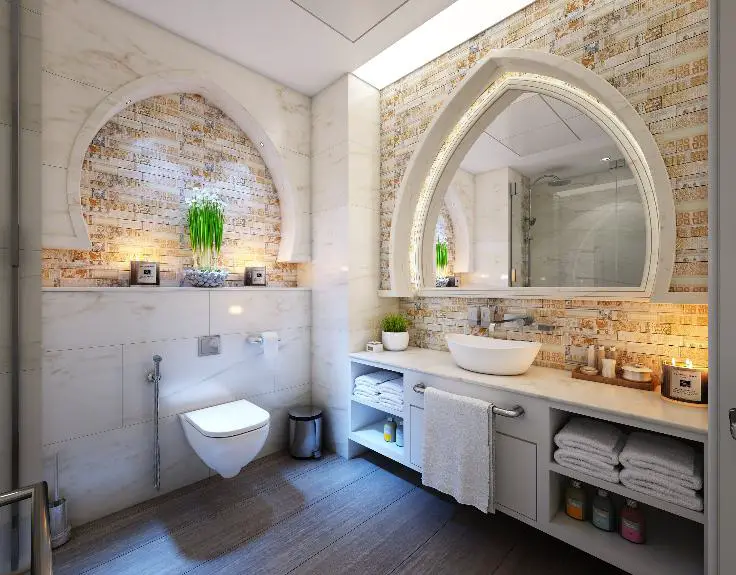The National Electrical Code requires that bathroom outlets have GFCI protection.
There is no set minimum distance between a toilet and an outlet, but outlets should be placed within reach for convenience while maintaining a safe distance from water sources.
Professional installation is recommended for safe and practical bathroom electrical setups.
Understanding GFCI Requirements
A Ground Fault Circuit Interrupter (GFCI) outlet is designed to cut power when a ground fault occurs, which is particularly important in bathrooms due to the proximity of outlets to water sources such as sinks. The National Electrical Code (NEC) requires that all bathroom outlets be GFCI-protected and installed no more than 36 inches from the sink to ensure safety for bathroom appliances and to reduce the risk of electric shock where water is present.
When installing GFCI outlets in bathrooms, one must consider the layout and how bathroom fixtures are used. GFCI outlets are necessary near water sources like sinks, but they should not be installed inside bathtubs or shower stalls. They should be placed conveniently for appliances such as heated toilet seats or bidets, but not behind toilet tanks where they are inaccessible.
Installing GFCI outlets in bathrooms is a safety requirement and a precautionary step to prevent electrical hazards. Professional installation typically costs between $130 and $300, reflecting the importance of expert services in maintaining electrical safety in the bathroom.
National Electrical Code Guidelines
The National Electrical Code (NEC) requires electrical outlets to be at least three feet away from toilets to prevent electrical hazards caused by the proximity of water and electricity. Despite the use of GFCI (Ground Fault Circuit Interrupter) outlets, which significantly lower the risk of electrocution, this distance requirement remains to maintain consistent safety standards.
GFCI outlets are necessary in bathrooms due to the presence of moisture. However, the NEC strictly prohibits the installation of outlets within or immediately next to showers to eliminate the risk of water or steam compromising electrical safety.
Compliance with the NEC is essential for the safety of building occupants.
Outlet Placement Best Practices
Outlet placement in bathrooms must comply with safety standards and provide practical use. Outlets near toilets require GFCI protection to prevent electrical shock. They should be easily accessible for appliances but positioned away from water sources to reduce the risk of water contact.
It is not recommended to install outlets directly above the toilet tank due to the risk of water damage. The National Electrical Code (NEC) requires outlets to be within three feet horizontally and eight feet vertically from the bathtub or shower space, but this does not apply to toilets.
Proper outlet placement considers both safety and functionality, preventing electrical overloading while maintaining a safe bathroom environment.
Addressing Common Safety Concerns
Electrical safety in bathrooms requires that outlets are not placed too close to toilets to avoid the risk of water coming into contact with electricity. The National Electrical Code (NEC) recommends that outlets should be GFCI protected to prevent electric shock. The NEC suggests a minimum distance of three feet from the toilet to any outlet, which helps reduce the chance of water splashing onto electrical components.
GFCI outlets are important in bathrooms to quickly cut off the electrical current if a leakage is detected, preventing electric shock. These outlets are especially necessary for electric toilet accessories like bidets or heated seats. While GFCI outlets can be near toilets, they should still follow the recommended distance of at least three feet for safety.
To enhance safety, it is better to keep a distance of six feet between the toilet and any outlet where possible, and ensure all bathroom outlets are GFCI protected. This approach helps mitigate safety risks in bathroom electrical setups.
Cost Implications of Installation
When installing a GFCI outlet in a bathroom, it's important to account for the costs involved. A GFCI outlet typically costs between $7 and $25. Labor costs for electricians range from $40 to $100 per hour, depending on the job's complexity. A simple installation might be at the lower end of this range, while adding multiple outlets could be more expensive.
Investing in GFCI outlets is crucial for safety and complies with safety codes. Despite some homeowners having the ability to install these themselves, it is advisable to hire a professional to ensure the installation is done correctly and safely.
Professionals may also suggest products that adhere to safety standards, which should be factored into the overall budget. Homeowners should consider both the price of the outlet and the cost of labor when planning for installation.





